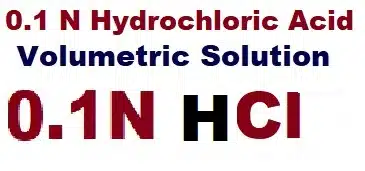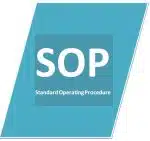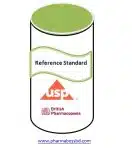Learn how to prepare and standardize 0.1 N Hydrochloric acid VS (Volumetric Solution) as per the United States Pharmacopoeia (USP) in the quality control laboratory.

Materials Required
1. Hydrochloric acid (HCl)
2. Carbon dioxide-free water (freshly boiled and cooled distilled or deionized water)
3. Tromethamine / Trometamol / TRIS
4. Analytical balance
5. Volumetric flask (1 L) 1000 mL
6. Burette and pipettes
7. pH indicator (e.g., Bromocresol Green)
Procedure for Preparation 0.1 N Hydrochloric acid solution (HCl)
1. Measure approximately 8.5 mL of Hydrochloric acid (HCl).
2. Carefully transfer the Hydrochloric acid into a 1000 ml of volumetric flask containing about 400 mL of carbon dioxide-free water.
3. Stir to mix the Hydrochloric acid completely.
4. Fill the solution to the 1000 ml mark with carbon dioxide-free water.
5. Stopper the flask and mix well by inverting it several times.
Standardization of 0.1 N Hydrochloric acid Solution (HCl)
The solution must be standardized against a primary standard, such as Tromethamine (KHP), which is a stable, high-purity compound used for standardization.
Procedure
1. Accurately weigh about 0.500 g of Tromethamine, previously dried at 105°C temperature for 3 hours.
2. Now transfer the weighed Tromethamine in 250 ml of conical flask with 50 ml of carbon dioxide free water.
3. Dissolve it properly.
4. Add two drops of bromocresol green TS indicator to the solution.
5. Titrate the Tromethamine solution with the 0.1 N Hydrochloric acid solution from the burette to the production of a pale yellow color.
6. Record the volume of Hydrochloric acid solution (HCl) used (Titrant).
Each 12.114 mg of Tromethamine is equivalent to 1 ml of 0.1 N Hydrochloric acid solution.
Factor Calculation of Normality
Use the following equation to calculate the exact normality of the HCl solution:
N = grams of benzoic acid / 0.012114 X mL of Hydrochloric acid solution
| N = | grams of Tromethamine |
| 0.012114 X mL of Hydrochloric acid solution |
Note: Triplicate the titration for standardization and average the result..
Labeling and Storage
1. Label the solution with its concentration and the date of preparation.
2. Store the HCl solution in a tightly closed container.
Precautions
1. Always use gloves and eye protection when handling HCl, as it is a strong acid and can cause burns.
2. Ensure that the water used is free from carbon dioxide.
Reference: United State Pharmacopoeia (USP) volume 4
Related Topics:
- Prepare and Standardize 1 N Hydrochloric Acid VS
- Prepare and Standardize 1 N Sodium Hydroxide VS
- Prepare and Standardize a 0.1 N Sodium Hydroxide VS
- Prepare and Standardize 0.5 N Sodium Hydroxide VS

Abdus Sobhan Salim is professional experienced pharmacist in pharmaceuticals, author and founder of pharmabossbd.com, the first Bangladeshi pharmaceutical blogger since 2019.



